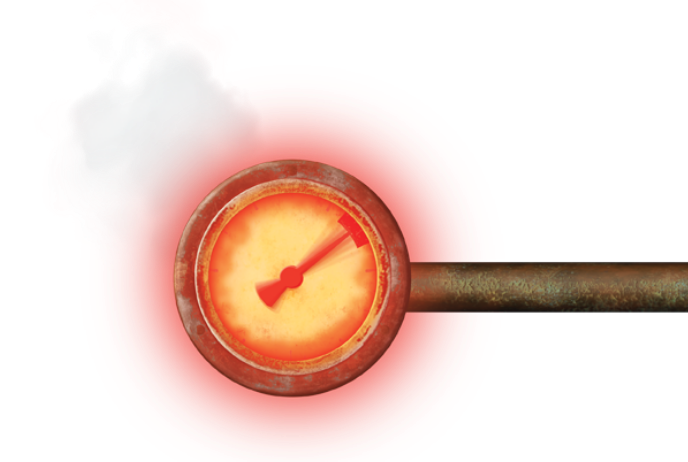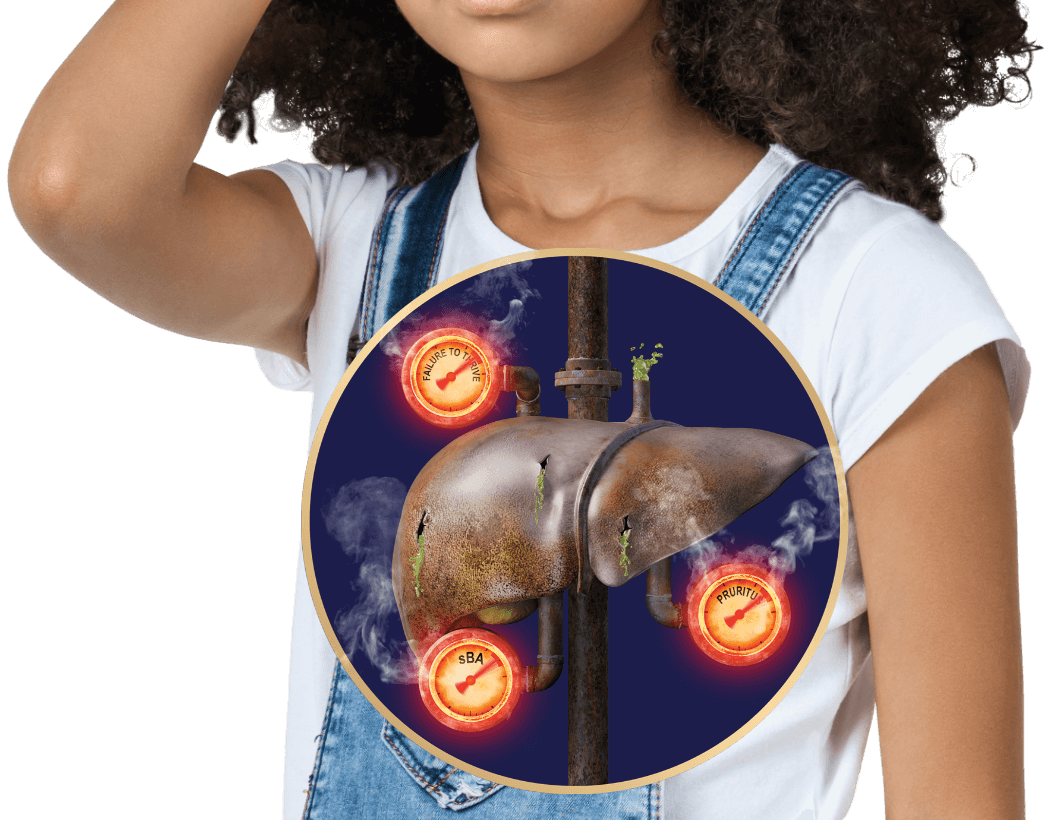Pruritus is a debilitating and challenging symptom in cholestatic liver diseases (ChLD)
Impact of pruritus
The impact of pruritus extends beyond scratching and can lead to issues including, but not limited to
Cutaneous
mutilation,
scarring1,2
Sleep deprivation1,2
Disrupted
school activity1,2
Emotional
distress1,2
Impact on
caregiver’s personal
and family
activities3,4
Impact on
caregiver’s
employment and
finances3,5,6
Despite the considerable burden of disease, pruritus is often underreported7,8
- Patients experiencing chronic illnesses are motivated to accommodate symptoms
- They often adapt to symptoms like pruritus, minimizing the true impact and accepting symptomatic disease as their new normal
Pruritus has a substantial impact on activities
of daily living

All images are actor portrayals.
Sleep disturbances
Strong correlations between sleep disturbances and self-reported QoL have
been observed in patients with ChLD


of PFIC caregivers report that their child needed soothing or help falling asleep due to itching10*


of ALGS patients and caregivers report difficulty falling asleep due to itching, and 59% report difficulty staying asleep2†
When pruritus remains uncontrolled, patients with
ChLD also report issues with2,11,12
School performance
Overall mood
Daily activities
*Based on responses from 62 caregivers in a study to validate the PRUCISION™ ObsRO tool for patients with PFIC.
†Based on responses from 24 caregivers and 12 patients in a study to validate the PRUCISION™ ObsRO tool for patients with ALGS.
Failure to thrive due to ChLD causes detrimental delays in growth and development
Failure to thrive
In PFIC and ALGS, failure to thrive is associated with
Impaired
growth13,14
Poor weight gain13,14
Use of a feeding tube
(ALGS patients)4
In patients with PFIC 1,
90% report failure to thrive13
PFIC 1 and PFIC 2 patients also present with
sequelae of vitamin deficiency, including13
Coagulopathy • Rickets • Seizures


PFIC 1 and PFIC 2 patients also present with sequelae of vitamin deficiency, including13
Coagulopathy • Rickets • Seizures


Malabsorption of vital nutrients in patients with ALGS can also lead to15
Rickets • Vision problems • Poor coordination • Developmental delays • Blood clotting problems
In patients with ALGS,
up to 87% report significant growth deficiencies and failure to thrive14
Malabsorption of vital nutrients in patients with ALGS can also lead to15
Rickets • Vision problems • Poor coordination • Developmental delays • Blood clotting problems
Caregivers and their families share the burden of ChLD
Caring for a child with any rare disease can have a considerable impact on a caregiver's physical and mental health16

Caring for a child with any rare disease can have a considerable impact on a caregiver's physical and mental health16
1 in 3
rate their physical health as fair or poor16
PFIC
In a study of caregivers for children with PFIC3
Of 22 caregivers
who participated in the study
HOME
86%

had difficulty sleeping
HOME
82%

reported impacts on personal relationships
Of 16 caregivers
who were currently working a paying job
WORK & CAREER
73%

were prevented from progressing in their careers or working more hours
WORK & CAREER
36%

missed years of employment*
*Missing an average of 2.8 years of employment.
ALGS
Caring for someone with ALGS can take a toll on caregivers
Compared to caregivers within a general population, ALGS caregivers report4
Limitations of
personal time
Increased
stress
Interruption of
family activities
A higher proportion of caregivers of children with ALGS report anxiety and depression compared
to UK population norms5


Caring for a child with ChLD can be incredibly challenging, but resources are available

ChLD=cholestatic liver diseases; ObsRO=observer-reported outcomes; QoL=quality of life.
References: 1. Srivastava A. Progressive familial intrahepatic cholestasis. J Clin Exp Hepatol. 2014;4(1):25-36. 2. Kamath BM, Abetz-Webb L, Kennedy C, et al. Development of a novel tool to assess the impact of itching in pediatric cholestasis. Patient. 2017;11:69-82. 3. Mighiu C, O’Hara S, Ferri Grazzi E, et al. Impact of progressive familial intrahepatic cholestasis on caregivers: caregiver-reported outcomes from the multinational PICTURE study. Orphanet J Rare Dis. 2022;17(1):1-9. 4. Elisofon SA, Emerick KM, Sinacore JM, Alonso EM. Health status of patients with Alagille syndrome. J Pediatr Gastroenterol Nutr. 2010;51(6):759-765. 5. Quadrado L, Mogul DB, Gurevich A, et al. Caregiver burden associated with caring for a child with Alagille syndrome: a multi-national, quantitative analysis. Presented at: North American Society for Pediatric Gastroenterology, Hepatology and Nutrition (NASPGHAN) Annual Meeting; October 12-15, 2022; Orlando, FL, USA. 6. Ebel NH, Goldstein A, Howard R, et al. Health care resource utilization by patients with Alagille syndrome. J Pediatr. 2023;253:144-151. 7. Kini SP, Delong LK, Veledar E, McKenzie-Brown AM, Schaufele M, Chen SC. The impact of pruritus on quality of life: the skin equivalent of pain. Arch Dermatol. 2011;147(10):1153-1156. 8. Brown A, Hayden S, Klingman K, Hussey LC. Managing uncertainty in chronic illness from patient perspectives. JENHP. 2020;2(1):1-16. 9. Kamath BM, Stein P, Houwen RHJ, Verkade HJ. Potential of ileal bile acid transporter inhibition as a therapeutic target in Alagille syndrome and progressive familial intrahepatic cholestasis. Liver Int. 2020;40(8):1812-1822. 10. Gwaltney C, lvanescu C, Karlsson L, Warholic N, Kjems L, Horn P. Validation of the PRUCISION instruments in pediatric patients with progressive familial intrahepatic cholestasis. Adv Ther. 2022;39:5105-5125. 11. Jones-Hughes T, Campbell J, Crathorne L. Epidemiology and burden of progressive familial intrahepatic cholestasis: a systematic review. Orphanet J Rare Dis. 2021;16(1):1-14. 12. Mehl A, Bohorquex H, Serrano M-S, Galliano G, Reichman TW. Liver transplantation and the management of progressive familial intrahepatic cholestasis in children. World J Transplant. 2016;6(2):278-290. 13. Pawlikowska L, Strautnieks S, Jankowska I, et al. Differences in presentation and progression between severe FIC1 and BSEP deficiencies. J Hepatol. 2010;53(1):170-178. 14. Kamath BM, Baker A, Houwen R, Todorova L, Kerkar N. Systematic review: the epidemiology, natural history, and burden of Alagille syndrome. J Pediatr Gastroenterol Nutr. 2018;67(2):148-156. 15. National Organization for Rare Disorders. Alagille syndrome. Updated May 13, 2020. Accessed February 22, 2023. https://rarediseases.org/rare-diseases/alagille-syndrome/?filter=ovr-ds-resources 16. National Alliance for Caregiving. Rare Disease Caregiving in America. February 2018.


